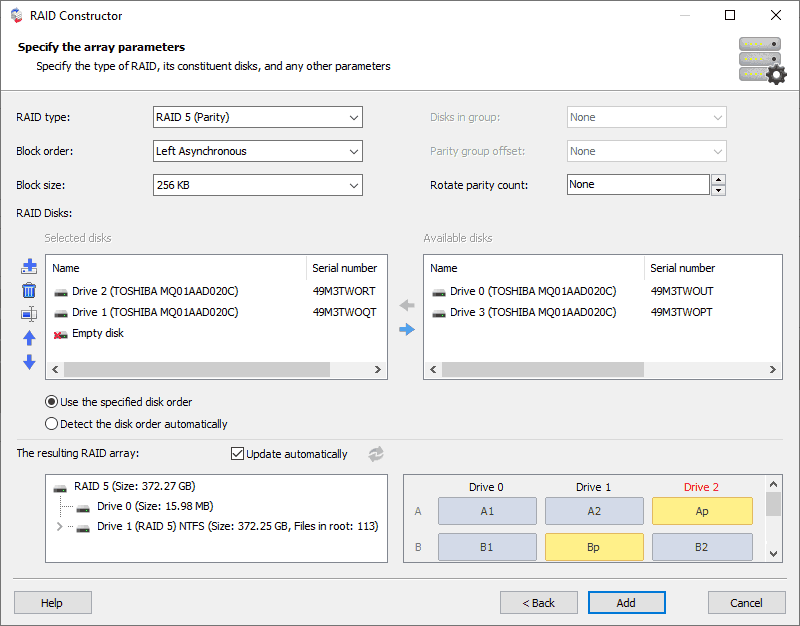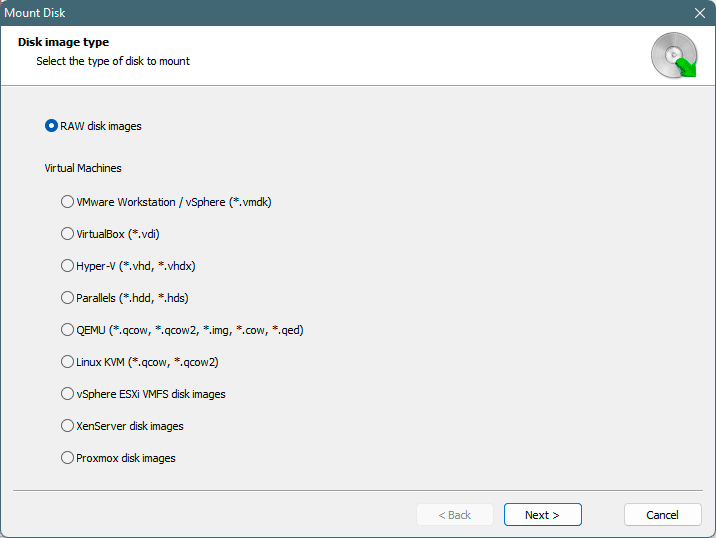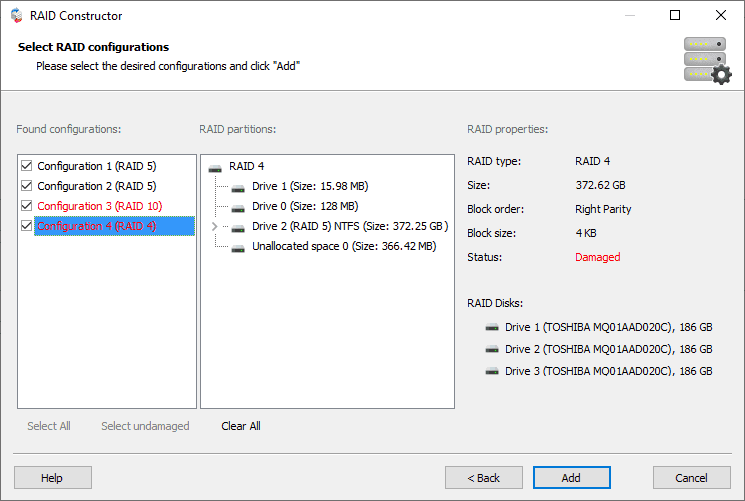Have you ever experienced the nightmare of data loss stored on a multi-disk array? Whether it’s due to a failed RAID controller, unrecoverable errors on one or several hard drives, or any other mishap causing data loss, RS RAID Retrieve is here to save the day. This comprehensive recovery software is your go-to solution for all things related to RAID data recovery.
RS Raid Retrieve 2.6
Data stored on a broken NAS unit or RAID array with a failed controller can be difficult to recover – but not if you use RS RAID Retrieve! The tool can automatically repair many types of RAID arrays, allowing to recover files and folders from multi-disk volumes without the original RAID controller.
Try For Free Buy NowWhether your disks were installed in a NAS unit, in a computer with a hardware RAID controller, or managed with mdadm in a Linux box, RS RAID Retrieve can reassemble and repair the storage spaces and recover your files and folders in just a few clicks.
Automatic RAID detection
One of the standout features of RS RAID Retrieve is its automatic RAID detection capability. With just a few clicks, the tool scans all connected media and identifies the essential configuration parameters of the RAID array. This saves valuable time and effort, allowing users to quickly initiate the recovery process without manual intervention.

Advanced Manual Mode
For users who prefer a more hands-on approach, RS RAID Retrieve offers an advanced manual mode. This mode allows users to specify RAID parameters manually, giving them full control over the recovery process. Whether you’re a novice or an experienced user, RS RAID Retrieve caters to your needs with its versatile functionality.

RAID, mdadm, RaidZ and Storage Spaces
RS RAID Retrieve is a robust data recovery software designed to tackle the complexities of RAID configurations. Whether you’re dealing with RAID 0, RAID 1, RAID 4, RAID 5, RAID 6, composite arrays configurations RAID 01, RAID 10, RAID 50, RAID 60 or even exotic multi-disk arrays (RAID 1E, RAID 5E, RAID 5EE), RS RAID Retrieve has you covered. Its intuitive interface and advanced algorithms make the recovery process seamless and efficient
Data recovery from virtual machines (Virtual Machines, VM)
Using the RS RAID Retrieve allows you to recover data from a virtual machine such as VMware Workstation, VMware vSphere, VMware ESXi, Parallels Hypervisor, QEMU, ORACLE VirtualBox, Microsoft Hyper-V, Linux KVM, Citrix XenServer, Proxmox Virtual Environment.

Retrieves Data from Degraded RAID Arrays
RS RAID Retrieve prioritizes your data against anything else. While out-of-the-box NAS devices will try to repair the degraded array, often causing yet another disk to fail, RS RAID Retrieve will try to recover your data instead. No lengthy RAID rebuilds and no resilvering, just straight off data recovery.
Recover Data from Corrupted Volumes
Storage space corruption is just as likely as a RAID failure. A perfectly healthy multi-disk array may hold a corrupted logical volume. RS RAID Retrieve can automatically repair corrupted volumes spanned across multiple disks, repairing partition tables and file system structures if necessary to allow you safely extracting the original files and folders.
RAID and NAS Devices
There are more NAS devices than personal computers with multiple disk arrays, and RS RAID Retrieve certainly takes that fact into account. If your hard drives were used in a NAS box manufactured by Synology, QNAP, ASUSTOR, Western Digital, Thecus, TerraMaster, Buffalo or one of the other popular makers, RS RAID Retrieve can automatically detect, reassemble and repair the storage spaces, mount logical disk volumes and recover your data. Simply attach the hard drives directly to your computer and let RS RAID Retrieve do its job!
Fault Tolerance and Beyond
Several types of multi-disk arrays use striping and checksums to ensure data integrity even if a certain number of disks fail. A RAID 5 array can tolerate a single disk failure without losing a bit of your data. A RAID 6 can lose up to two disks and still hold all the data intact. RS RAID Retrieve will mount degraded RAID arrays and recover the files and folders.

But what if the number of failed hard drives exceeds the fault tolerance threshold? If this happens, your NAS or RAID controller will fail to mount the storage space, effectively locking you out. RS RAID Retrieve will perform complex math to attempt partial data recovery from such arrays. How much is recoverable and whether the recovery is at all possible will depend on the original RAID configuration, the number of failed hard drives and several other parameters such as stipe size.
Disks with Bad Blocks
A single bad block may throw an otherwise healthy hard drive out of the array, causing subsequent rebuild attempts to fail. RS RAID Retrieve is designed to work around bad blocks graciously, recovering everything that’s still recoverable and only skipping the bits in the bad blocks.
Supported File Systems
RS RAID Retrieve supports a wide range of file systems and RAID types, including NTFS, ReFS, FAT, exFAT, APFS, HFS+, Ext2/3/4, XFS, ReiserFS, Btrfs, Zfs, UFS 1/2, and more. Whether your disks were installed in a NAS unit, a computer with a hardware RAID controller, or managed with mdadm in a Linux box, RS RAID Retrieve can handle them all.
Built-in and Dedicated RAID Controllers
RS RAID Retrieve supports a wide range of dedicated RAID controllers manufactured by HP, Dell, Adaptec and many others, including server models. In addition, the tool supports multi-disk configurations maintained by the RAID controllers built into most Intel motherboards. Please note that you will need to temporarily disable the built-in RAID controller in your computer’s BIOS when using RS RAID Retrieve to repair the array.
Features at a Glance
- Automatically detects and reassembles multi-disk volumes;
- Detects and rebuilds corrupted RAID arrays created in Windows, Linux and NAS devices;
- Supports RAID 0, RAID 1, RAID 4, RAID 5, and RAID 6;
- Supports RAID 1E, RAID 5E, RAID 5EE and composite arrays such as RAID 01, RAID 10, RAID 50, and RAID 60;
- Mounts multi-disk storage spaces even if the original RAID controller is unavailable;
- Recovers files and folders from healthy and corrupted multi-disk arrays;
- Recognizes most common file systems including NTFS, ReFS, FAT, exFAT, APFS, HFS+, Ext2/3/4, XFS, ReiserFS, Btrfs, Zfs and UFS 1/2;
- Automatically detects disk order and RAID parameters;
- Advanced manual mode offers fully manual or semi-automatic operation;
- Partial data recovery from RAID 5 and RAID 6 arrays crashed beyond fault tolerance threshold;
- Recovers data from single-disk volumes and JBOD arrays;
- Avoids array rebuild and resilvering for mirrored and checksum arrays;
What's New?
14 July 2023
- Improved algorithm for detecting remote raid arrays
- Expanded the list of supported RAID controller models from LSI Logic, 3ware, and Dawicontrol.
- Addressed an issue related to reading the MBR table when a significant number of logical partitions are present.
- The file preview error for the ReFS file system has been fixed
- Implemented support for LVM Thin Provisioning with "Tier Thin Pool."
- Enhanced the XFS file system to support large files and sparse files


